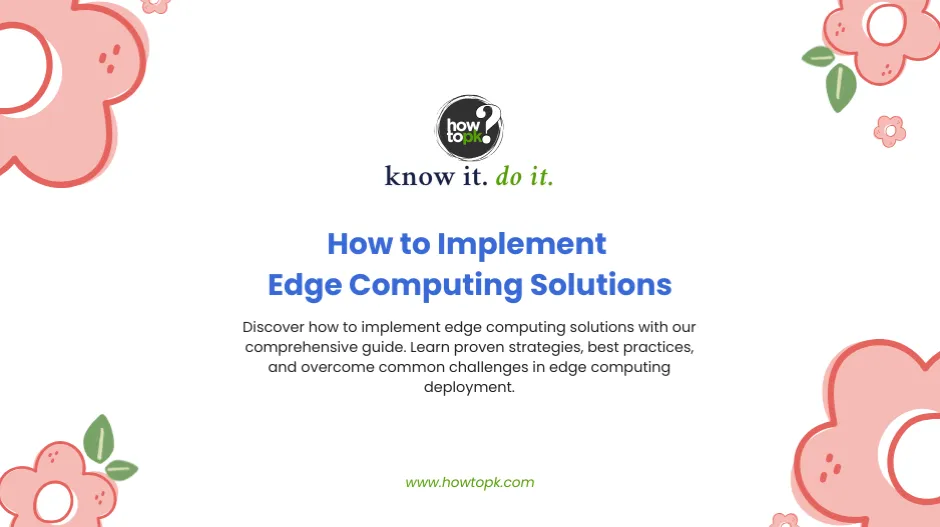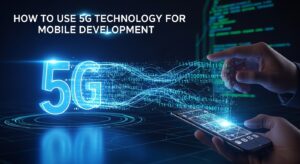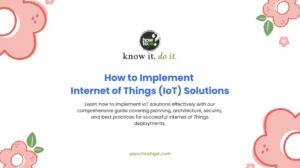How to implement edge computing solutions effectively has become one of the most critical questions facing IT leaders today. As organizations seek to reduce latency, improve performance, and enhance data privacy, edge computing solutions are transforming how we process and analyze data at the network’s edge.
Understanding Edge Computing Solutions Fundamentals
Before diving into implementation strategies, let’s explore what makes edge computing solutions so transformative. Edge computing brings computation and data storage closer to where data is generated, rather than relying on centralized cloud infrastructure.
Think about this scenario: How might a manufacturing plant benefit from processing sensor data locally rather than sending it to a distant cloud server? The answer lies in the milliseconds saved and the immediate responses enabled.
Key Components of Edge Computing Architecture
Edge computing solutions typically consist of several interconnected elements:
Hardware Infrastructure:
- Edge servers and micro data centers
- IoT devices and sensors
- Network equipment and gateways
- Storage systems optimized for edge environments
Software Stack:
- Container orchestration platforms
- Edge-specific operating systems
- Data processing and analytics tools
- Security and monitoring solutions
Strategy 1: Assess Your Current Infrastructure for Edge Computing Solutions
The first step in implementing edge computing solutions involves conducting a thorough assessment of your existing infrastructure. This evaluation will help you identify gaps and opportunities.
Infrastructure Assessment Framework
Assessment Area | Key Questions | Expected Outcomes |
Network Capacity | What is your current bandwidth utilization? | Bandwidth requirements for edge deployment |
Hardware Inventory | Which devices can support edge workloads? | Hardware upgrade and procurement needs |
Application Portfolio | Which applications would benefit from edge processing? | Prioritized list of edge-ready applications |
Security Posture | How will edge computing affect your security model? | Security architecture modifications needed |
Consider this: If you’re running real-time analytics on customer behavior data, what would happen if that processing occurred at each retail location rather than in a central data center? The insights would be immediate, and the customer experience could be personalized in real-time.
For comprehensive infrastructure planning, the Linux Foundation’s Edge Computing initiative provides valuable frameworks and best practices.
Strategy 2: Design Your Edge Computing Architecture
Designing effective edge computing solutions requires careful consideration of your specific use cases and constraints. The architecture should balance performance, cost, and complexity.
Edge Computing Deployment Models
- Distributed Edge Model: This approach places computing resources at multiple edge locations, ideal for organizations with geographically distributed operations.
- Regional Edge Model: Consolidates edge resources in regional hubs, offering a middle ground between centralized and fully distributed approaches.
- Device Edge Model: Pushes computing directly to end devices, maximizing responsiveness for time-critical applications.
Which model would best serve your organization’s needs? Consider factors like data sensitivity, latency requirements, and operational complexity.
Network Design Considerations
When implementing edge computing solutions, network design becomes crucial. You’ll need to consider:
- Connectivity redundancy between edge sites
- Quality of Service (QoS) requirements
- Network security segmentation
- Bandwidth allocation strategies
The Open Networking Foundation offers detailed guidance on network architectures for edge computing deployments.
Strategy 3: Select and Deploy Edge Computing Technology Stack
Choosing the right technology stack for your edge computing solutions can make or break your implementation. The selection process should align with your technical requirements and organizational capabilities.
Container Orchestration for Edge
Modern edge computing solutions often leverage containerization for application deployment and management. Popular options include:
- Kubernetes at the Edge: Projects like K3s and MicroK8s provide lightweight Kubernetes distributions optimized for edge environments.
- Docker and Container Runtimes: Container technologies enable consistent application deployment across diverse edge hardware.
How familiar is your team with container technologies? This knowledge gap analysis will help determine training needs and implementation timelines.
Edge-Specific Software Platforms
Several platforms are specifically designed for edge computing solutions:
- AWS IoT Greengrass: Extends AWS services to edge devices
- Microsoft Azure IoT Edge: Brings cloud analytics to edge devices
- Google Cloud IoT Edge: Enables on-premises data processing
Each platform offers unique advantages. What criteria would you use to evaluate which platform best fits your requirements?
For detailed platform comparisons, the Cloud Native Computing Foundation maintains comprehensive resources on edge computing technologies.
Strategy 4: Implement Security and Compliance Measures
Security represents one of the most critical aspects of edge computing solutions implementation. The distributed nature of edge computing introduces unique security challenges.
Edge Security Framework
Device Security:
- Secure boot processes
- Hardware-based trust anchors
- Regular firmware updates
- Device authentication mechanisms
Network Security:
- Encrypted communications
- Network segmentation
- Intrusion detection systems
- VPN connectivity
Data Security:
- Encryption at rest and in transit
- Access control mechanisms
- Data governance policies
- Compliance monitoring
Consider this challenge: How would you ensure that sensitive customer data processed at edge locations maintains the same security standards as your centralized systems?
Compliance Considerations
Edge computing solutions must address various regulatory requirements:
- GDPR for data protection in Europe
- HIPAA for healthcare data in the United States
- Industry-specific regulations like PCI DSS
The National Institute of Standards and Technology (NIST) provides comprehensive cybersecurity frameworks applicable to edge computing environments.
Strategy 5: Monitor, Optimize, and Scale Your Edge Computing Solutions
Successful edge computing solutions require ongoing monitoring, optimization, and scaling strategies. This continuous improvement approach ensures long-term success.
Monitoring and Observability
Performance Metrics:
- Application response times
- Resource utilization rates
- Network latency measurements
- Error rates and system reliability
Operational Metrics:
- Device health and status
- Security incident tracking
- Compliance audit results
- Cost optimization opportunities
What key performance indicators would be most valuable for your specific edge computing use cases?
Scaling Strategies
As your edge computing solutions prove successful, you’ll need strategies for scaling:
- Horizontal Scaling: Adding more edge locations to serve additional geographic areas or user bases.
- Vertical Scaling: Increasing computing capacity at existing edge locations.
- Application Scaling: Expanding the number of applications running at edge locations.
Common Challenges in Edge Computing Implementation
Understanding potential challenges helps you prepare for successful edge computing solutions deployment:
Technical Challenges
- Connectivity Issues: Edge locations may have limited or unreliable internet connectivity. How would you design your architecture to handle intermittent connectivity?
- Resource Constraints: Edge devices often have limited computing, storage, and power resources compared to centralized data centers.
- Management Complexity: Distributed infrastructure can be more complex to manage and troubleshoot than centralized systems.
Organizational Challenges
- Skills Gap: Many organizations lack the specialized skills needed for edge computing solutions implementation.
- Change Management: Shifting from centralized to distributed computing models requires significant organizational change.
- Cost Considerations: Initial implementation costs for edge computing solutions can be substantial.
For additional insights on overcoming these challenges, the Edge Computing Consortium provides industry best practices and case studies.
Best Practices for Edge Computing Solutions Success
- Start Small and Scale Gradually: Begin with pilot projects that demonstrate clear value before expanding your edge computing solutions across the organization.
- Focus on Use Cases with Clear ROI: Prioritize implementations where edge computing provides measurable benefits like reduced latency, improved user experience, or cost savings.
- Invest in Team Training: Ensure your team has the necessary skills to design, implement, and maintain edge computing solutions effectively.
- Plan for Long-term Maintenance: Edge computing solutions require ongoing maintenance, updates, and support. Factor these operational costs into your planning.
Future Trends in Edge Computing Solutions
As edge computing continues evolving, several trends are shaping the future:
- 5G Integration: The rollout of 5G networks will enable new edge computing use cases with ultra-low latency requirements.
- AI at the Edge: Machine learning models are increasingly being deployed at edge locations for real-time inference.
- Edge-to-Cloud Integration: Hybrid architectures that seamlessly integrate edge and cloud resources are becoming more sophisticated.
What emerging trends do you think will have the greatest impact on your edge computing solutions strategy?
Conclusion
Implementing edge computing solutions successfully requires careful planning, the right technology choices, and a commitment to ongoing optimization. By following these five proven strategies, organizations can harness the power of edge computing to improve performance, reduce costs, and enable new capabilities.
The future belongs to organizations that can effectively leverage distributed computing resources to deliver superior user experiences and operational efficiency. With proper planning and execution, your edge computing solutions can provide significant competitive advantages in today’s digital landscape.











